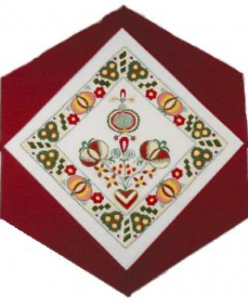Czech Republic

The Block
An example of traditional folk embroidery is featured on the Czech Republic block, created by Niki Tichakova. Densely packed long stitches, in contrasting tones, speak to the unique nature of Czech needlework as demonstrated in the stylized fruit and floral design. Both the motifs and colours, worked on a background of fine linen, are characteristic of the elaborate embroidery that typically decorates many elements of the national folk costumes including blouses, aprons, caps, shawls, and skirts, as well as household linens.
Cultural Profile
Czech Republic is a landlocked country in Central Europe. It is divided into two main regions, Moravia and Bohemia. Moravia takes its name from the Morava River and its capital, Brno, was once one of Europe’s largest textile centres. Bohemia is sometimes called “the roof of Europe” since no rivers or streams flow into the country, but many flow out of it. Its capital, Prague, is often referred to as “the city of a hundred spires” because of its many beautiful churches. The people of the Czech Republic are 94% ethnic Czechs and 3% Slovak. The rest of the population is comprised of Polish, Germans, Hungarians and Roma (Gypsies).The official language is Czech.
Czechs’ appreciation for sports is embodied in the Sokol Movement, a gymnastic society founded in 1862 to promote Czech culture and social life, and to cultivate physical, cultural and intellectual development among its members. The movement has expanded beyond Czech borders and currently has chapters in several European nations, as well as in the United States.
Czechs also love music and the country is world-famous for producing high-quality stringed, wind, organs and wooden instruments. Tapestry is still being made in places such as Valašské Meziříčí. Other national crafts include bobbin lace-making, especially in the town of Vamberk, woodcarving, pottery often displaying vivid orange tones, and porcelain featuring the blue onion pattern. Delicate Bohemian hand-made crystal is renowned for its high quality, and glass workers still use many of the same techniques as their ancestors did 600 years ago. The country also has a preeminent theatrical tradition, which has been passed down from generation to generation, as well as a strong literary tradition, with authors such as Franz Kafka and Milan Kundera. Traditional costumes vary from village to village, region to region; however, they always features colourful embroidery and particulars; for example, the women of the Plzen region were known to wear up to 24 underskirts, thus limiting their movements.
Early Czech immigrants to Canada, including four farmers named Pangrác, Junek, Doležal and Skokan, settled on the prairies and established small farming communities in southeastern Saskatchewan, specifically Kolin in 1884. In later years, others came to Edmonton, Kingston, Windsor and Winnipeg, working as artisans, entrepreneurs, construction workers and railroad navvies. Following WWI, many immigrants settled in Montréal, which replaced Winnipeg as the largest Czech settlement area in Canada until WWII.
Czechs made contributions in many different fields in Canada. Creating their own factories, they introduced new products and methods and also provided many employment opportunities. The most well-known businessman is Thomas J. Bata, who relocated staff from Bata shoe factories in Moravia to Canada, thus creating the town of Batawa near Frankfurt, Ontario. Czechs have also contributed much to the world of performing arts through such luminaries as conductor Walter Susskind, composer Oskar Morawetz and singer/actor Jan Rubes. Czechs share Canadians’ love of hockey; many hockey players in the NHL who made a lasting contribution to the sport, such as Jaromir Jagr, Thomas Plekanec or Patrik Elias, hail from the Czech Republic, while their national teams are always serious contenders for Olympic medals and World Championships.
As of 2011, there were over 94,000 people of Czech origins living in Canada.
Sponsor: Masaryk Memorial Institute
